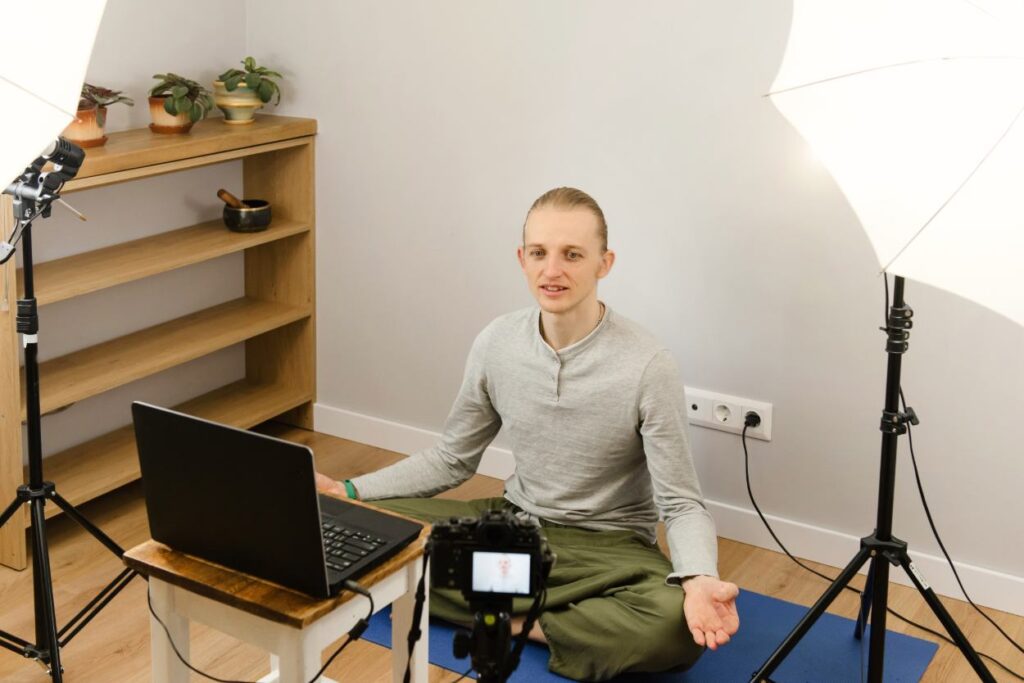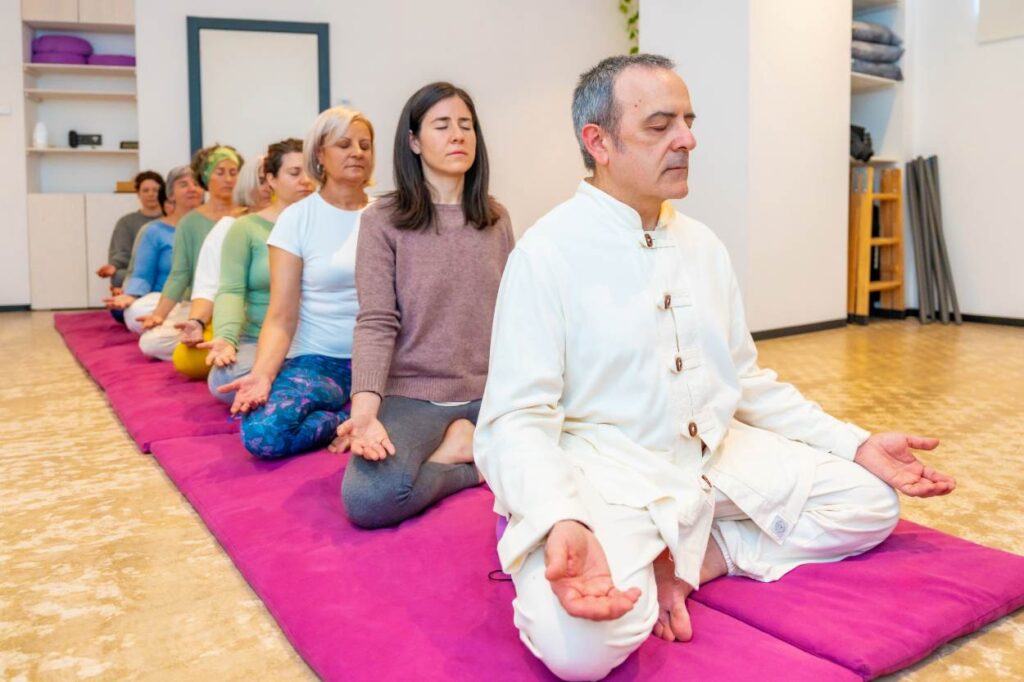Across the UK, meditation and mindfulness are no longer fringe interests, they’ve become essential tools for managing the challenges of modern life. As conversations around mental health and wellbeing move into the mainstream, more people are seeking ways to reduce stress, improve focus, and feel more connected in their day-to-day lives.
This shift is creating a powerful opportunity for those who feel called to teach these therapeutic support systems. According to the British Mindfulness Institute, demand for qualified teachers has never been greater. The World Health Organisation predicts that by 2030, mental health issues will place a heavier burden on healthcare than heart disease or cancer, highlighting the urgent need for accessible, preventative approaches. Mindfulness-Based Cognitive Therapy (MBCT), recommended by the National Institute for Clinical Excellence (NICE), has been shown to prevent relapse in half of recurrent depression cases, with neuroscience continuing to validate its benefits.
This demand poses a growing opportunity for those looking to develop skills as mindfulness and mediation teachers. Let’s explore the rise of mindfulness in the UK, the reasons people are embracing it, where it’s being practised, and the many ways you can turn your passion for mindfulness or meditation into a meaningful and flexible career.
The rise of mindfulness
Mindfulness and meditation are now firmly in the mainstream. What was once seen as a niche interest is now being woven into everyday life, whether through guided sessions on popular apps, workplace wellbeing programmes, or weekly community classes.
Interest is visible online too, with searches for terms like “mindfulness training” and “how to meditate” increasing significantly, alongside strong growth in app downloads, online course enrolments, and retreat attendance.
This surge is also reflected in national health discussions. Mindfulness is increasingly recognised for its role in reducing anxiety, improving focus, and supporting overall wellbeing. With so many individuals and organisations embracing the practice, the need for skilled meditation and mindfulness teachers is expanding rapidly creating real opportunities for those ready to step into the space.
Why are people turning to mindfulness and meditation?

There’s no single reason, but rather a mix of modern challenges driving people to seek moments of stillness and clarity. Stress, burnout, and uncertainty about the future are all playing a part—but several themes stand out.
Attention and distraction
Our attention is constantly pulled in multiple directions emails, notifications, news alerts, and endless scrolling. Many people turn to mindfulness as a way to retrain their focus, improve concentration, and spend more time in the present moment.
Digital burnout
While technology connects us, it also overwhelms us. Long hours in front of screens, constant connectivity, and online overload can leave people feeling drained. Mindfulness practices offer a chance to unplug and recharge mentally.
Rising anxiety
Economic pressures, global events, and everyday stresses have all contributed to higher anxiety levels. Meditation provides practical tools to calm the nervous system, regulate breathing, and create a greater sense of control.
Managing emotion
Mindfulness helps people notice and process their emotions rather than being swept away by them. For many, it’s a valuable skill for handling conflict, sadness, frustration, or overwhelm more constructively.
Seeking meaning and connection
Beyond stress relief, many are drawn to meditation for its deeper benefits: feeling more connected to themselves, others, and the world around them. In a fast-paced, often impersonal world, these moments of connection can be life-changing.
How is mindfulness practice expanding
Mindfulness is no longer confined to personal practice at home; it’s being integrated into daily life in structured and accessible ways. From classrooms to corporate offices and even GP surgeries, it’s becoming part of our cultural approach to wellbeing.
In schools
More UK schools are incorporating mindfulness into the school day, helping children and young people develop emotional resilience, focus, and healthy coping strategies. These skills not only support learning but also equip pupils for the challenges of life beyond the classroom.
In the workplace
Employers are increasingly recognising the benefits of mindfulness for staff wellbeing and productivity. Many organisations now offer regular sessions or workshops as part of their mental health programmes, giving employees the tools to manage stress, improve concentration, and build stronger working relationships.
Within healthcare
Medical professionals are recommending mindfulness-based approaches for a range of conditions, from managing stress and anxiety to supporting recovery from recurrent depression. Programmes like Mindfulness-Based Cognitive Therapy (MBCT) are endorsed by the National Institute for Clinical Excellence and increasingly offered through NHS services.
In the community
Mindfulness is thriving in community settings such as yoga studios, therapy rooms, and local wellbeing centres. These spaces make the practice accessible to people who may not encounter it at school or work, offering group classes, courses, and drop-in sessions.
Online and On-demand
With the rise of apps, streaming classes, and virtual courses, mindfulness is now accessible anywhere. This flexibility allows people to fit practice into their schedule, making it easier than ever to build a regular habit.
Mindfulness vs Meditation

Although the terms are often used interchangeably, mindfulness and meditation are not exactly the same thing. Mindfulness is the skill of paying deliberate attention to the present moment, whether you’re eating, walking, or simply breathing, without judgement. It can be practised at any time, during any activity.
Meditation, on the other hand, is a structured practice that often uses techniques such as focusing on the breath, repeating a mantra, or visualisation to help cultivate mindfulness (as well as other states of awareness or relaxation). In other words, meditation is one of the most common ways to develop mindfulness, but mindfulness itself can be woven into everyday life.
Exploring different types of meditation
Not all meditation is the same, and people are often drawn to different styles depending on their personality, lifestyle, or goals. Some prefer silent, breath-focused sessions, while others enjoy more dynamic or guided approaches.
Here are some popular types:
- Mindfulness Meditation – Often used in therapeutic settings to develop present-moment awareness and self-compassion.
- Zen or Vipassana Meditation – Traditional, often silent forms that emphasise stillness, discipline, and deep awareness.
- Guided Meditation – Led by a teacher or recording, making it ideal for beginners or themed practices such as stress relief or sleep.
- Breathwork and Body Scans – Using the breath or systematic attention to the body to promote relaxation and emotional regulation.
- Walking or Movement Meditation – Mindful movement practices like walking meditation, yoga nidra, or qigong that combine awareness with gentle physical activity.
Understanding the differences between these approaches can help you tailor your own practice, or your teaching, to meet the specific needs of your students or clients.
Becoming a meditation teacher

If you feel inspired to share the benefits of mindfulness and meditation with others, becoming a certified teacher can be a deeply rewarding path. It allows you to guide individuals and groups towards greater calm, clarity, and connection, while building a meaningful career.
There are many training routes available, both in-person and online, catering to all levels of experience. Some focus solely on meditation, while others combine mindfulness, breathwork, and complementary wellbeing practices.
When choosing a course, consider:
- Accreditation and recognition – Is the qualification recognised by reputable industry bodies?
- Practical experience – Does the course include live teaching practice or observation?
- Ongoing support – Will you have access to mentorship or peer networks after you qualify?
- Flexibility – Does the training fit around your current work or lifestyle?
Beyond training, there are other important steps to prepare for teaching professionally:
- A dedicated space to practise – This could be a studio, community room, or even an online setup where you feel comfortable guiding sessions.
- Liability insurance – Having a specialist meditation teacher insurance is essential for protecting yourself and your students, whether teaching in person or online.
- Promoting your services – From creating a simple website or social media presence to networking with local studios, schools, or businesses, marketing will help you reach the people who need your support.
Becoming a meditation teacher is as much about developing your own practice as it is about leading others, so ongoing learning, reflection, and connection with your own teachers will help you grow in both skill and confidence.
Opportunities for teachers: A growing and flexible career
Training as a meditation teacher opens the door to a wide variety of ways to share your skills and support others. This is a profession that can adapt to your lifestyle, interests, and personal values—whether you want to work locally, travel, or teach entirely online.
Ways to share your skills
Once qualified, you could:
- Lead group classes or workshops – In community centres, studios, or as part of corporate wellbeing programmes.
- Offer private 1:1 sessions – Providing personalised guidance for individuals seeking deeper support.
- Work with schools, charities, or workplaces – Bringing mindfulness into environments where it can have a lasting impact.
- Host retreats or online programmes – Creating immersive experiences that help people deepen their practice.
- Create your own digital content – Such as a YouTube channel, podcast, or app-based meditation library.
Specialising in a niche
Focusing on a particular area can help you stand out and attract the right students. For example, breathwork training is a natural complement to meditation, offering techniques that can release tension, process emotions, and support mental clarity. You might also specialise in mindfulness for children, workplace wellbeing, or meditation for stress and anxiety.
Combining services
Many teachers weave meditation into a broader offering, combining it with coaching, yoga, counselling, or holistic therapies. This can enhance the value you provide, create more varied income streams, and allow you to meet the diverse needs of your clients.
Teaching meditation is more than just a profession, it’s an opportunity to make a meaningful difference in people’s lives while creating a career that offers flexibility, personal growth, and purpose.
So, is it time to get started?
We’re living in a time where more people than ever are looking inward, seeking calm, clarity and connection. Meditation and mindfulness are playing a key role in that journey, and teachers are needed to guide the way.
If you’ve felt the benefits of mindfulness in your own life and feel inspired to share them, this could be your moment. Whether you’re starting from scratch or looking to deepen your existing practice, becoming a meditation or breathwork teacher could be a powerful next step.
Get Meditation Teacher Insurance from Protectivity

*Disclaimer – This blog has been created as general information and should not be taken as advice. Make sure you have the correct level of insurance for your requirements and always review policy documentation. Information is factually accurate at the time of publishing but may have become out of date.
Last updated by
















